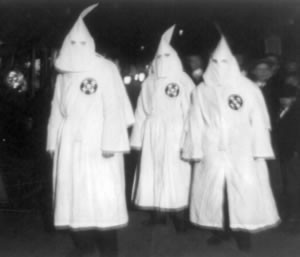Editor’s note: With so much news in the media about the removal of the Confederate flag, we thought it would be helpful for people to remember how the Klan has terrorized South Carolinians through the years. The recent issue of Statehouse Report includes a story that highlights how votes against removing the flag are clustered in the Upstate, which faced significant Klan activity during and after Reconstruction.
S.C. Encyclopedia | The Ku Klux Klan was a paramilitary organization formed during Reconstruction to oppose the Republican Party and restore white supremacy in the South.
Originally founded by former Confederate general Nathan Bedford Forrest in Tennessee in 1866, it spread to every southern state, including South Carolina, by 1868. Most authorities believe that these organizations were independent of each other, but within South Carolina the Klan clearly showed deference to the leading white Democrats. The Klan, or “Ku-Klux” as it was then called, engaged in a variety of violent actions, such as punishing alleged criminals or settling personal scores, but the vast majority of Klan actions were calculated to weaken the Republican Party by intimidating party leaders. Klansmen often whipped and sometimes killed people they regarded as Republican leaders. Victims of such attacks, or “outrages” in the parlance of the time, were almost always Republicans and were usually African Americans. The Klan was particularly strong in the predominantly white upcountry counties, and York County especially experienced a “reign of terror” in the late 1860s.
The Klan was shrouded in secrecy. Klansmen conducting outrages often went in disguise, the most famous of which consisted of white robes and white conical hoods. Others blackened their faces; still others did not disguise themselves, but rather operated outside their home neighborhoods so as not to be recognized. The suggestion that the white robes evoked superstitious fears in blacks seems to have little empirical justification; if African Americans feared Klansmen, it was not for supernatural reasons. Klansmen were often former Confederate troops, well armed and well trained in combat, and almost always on horseback. Furthermore, they had a well-deserved reputation for ruthlessness.
A typical attack might begin with a late-night raid on the home of a local Republican activist. The worst cases left victims disabled or dead; in other cases only threats were used. Most often the victim would be taken from his house and tortured, often by whipping, and ordered to renounce the Republican Party. Klansmen sometimes confiscated items such as guns or Republican electoral ballots, and they occasionally stole money. There were cases in which wives or children were beaten as well. The most frequent targets, however, were politically active men. Klansmen often justified their actions to the victim, telling him of some wrong he had done; usually the victim’s offense was a transgression against white supremacy. When the victim was white, he was often berated for advocating racial equality; when black, for thinking himself the equal of a white man.
Republicans defended themselves as circumstances permitted. Those who were wealthy or who enjoyed high official positions might arrange to have armed guards protect their homes. Humbler Republicans, on hearing that they were being targeted, might choose to sleep in the woods for a time. Residence in Columbia generally protected state legislators, but at least three (the native white Republicans Solomon Dill, James Martin, and Joseph Crews) were gunned down on highways traveling to or from the capital, and another (Benjamin Franklin Randolph, a mulatto from Ohio) was killed in broad daylight while boarding a train.
Democratic leaders frequently denied both the existence of the Klan and the reality of alleged outrages. When presented with indisputable evidence that attacks had occurred, they typically blamed “a few lawless men” for the violence, denying that there was any widespread conspiracy. Tradition holds that the Klan was populated by poor whites. It is more likely, however, that all strata of society were represented and that leadership in the Klan was provided by members of the gentry. Some known leaders included J. Rufus Bratton and James Avery of York and J. Banks Lyle of Spartanburg; other prominent Democrats, such as David Wyatt Aiken, were accused or even indicted for Klan-related violence. Furthermore, even if they or their sons were not members, many white leaders of the state openly sympathized with those being prosecuted on Ku-Klux charges. Wade Hampton III, Armistead Burt, and other leading citizens used their money and influence to provide the best attorneys possible for alleged Klansmen.
In 1871 and 1872 the administration of President Ulysses S. Grant made a large-scale effort to break the Klan, making an example of South Carolina. Declaring a state of rebellion, the president suspended the writ of habeas corpus in the counties of Spartanburg, Union, York, Chester, Laurens, Newberry, Fairfield, Lancaster, and Chesterfield. Federal prosecutors came south to indict hundreds of accused offenders. The size of the task overwhelmed the justice system, and few Klansmen were convicted. Historians debate the efficacy of the administration’s actions. The Klan as an organization ceased to exist, and many of its leaders fled the state. Nevertheless, political violence continued and eventually toppled the Reconstruction regime.
Another organization called the Ku Klux Klan was founded in 1915 after the success of the film Birth of a Nation, which glorified the Reconstruction Klan. This later Klan added an animus toward Jews and Catholics to the original motivation of preserving white supremacy. The twentieth-century Klan grew to include as many as three million members before it disbanded in the 1940s. Klan groups appeared again during the desegregation crisis of the 1960s and have occasionally been heard from since. The twentieth-century Klan existed in South Carolina but was not as prominent or politically powerful as in other states.
– Excerpted from the entry by Hyman S. Rubin III. To read more about this or 2,000 other entries about South Carolina, check out The South Carolina Encyclopedia by USC Press. (Information used by permission.)




 We Can Do Better, South Carolina!
We Can Do Better, South Carolina!
























